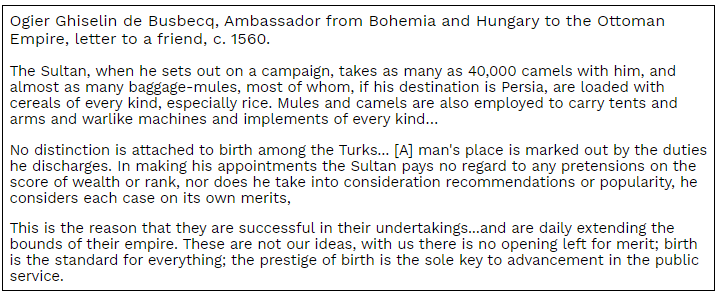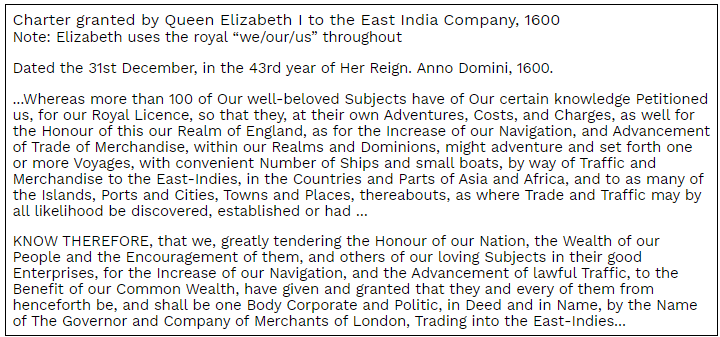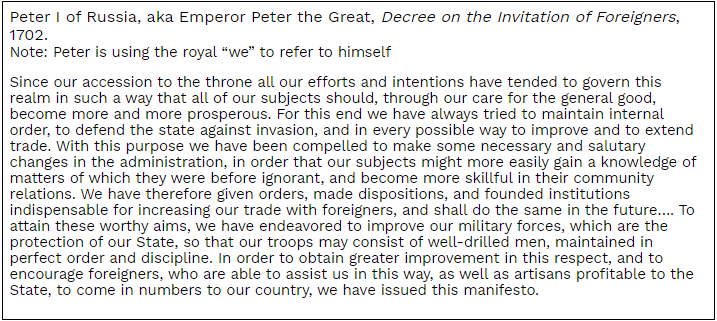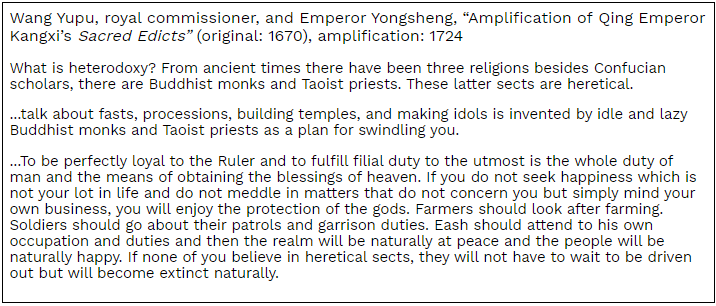AP World DBQ Contextualization and Thesis Practice
11 min read•january 2, 2021
Eric Beckman
Evan Liddle
Melissa Longnecker
AP World History: Modern 🌍
577 resourcesSee Units
Practicing DBQ prompts is a great way to prep for the AP exam! Review practice writing samples of the opening paragraph of a DBQ and corresponding feedback from Fiveable teachers Melissa Longnecker, Eric Beckman, and Evan Liddle.
The DBQ Practice Prompt
- This is the type of paragraph that can open a DBQ. But, I recommend outlining how you will use the documents as evidence before writing your thesis.
- As you read the document-based question, I recommend taking brief notes on the prompt and each document. Record what the prompt is asking, how each document relates to the prompt, and how the sourcing affects the document and/or a response to the prompt. Don’t write too much, but you will find these notes useful when while composing your answer.
The Prompt
Evaluate the extent to which rulers of early modern empires, c. 1450 - c. 1750, used traditional methods to consolidate their power.
Use the documents and your understanding of World History to write ONE (no more!) paragraph with
- Broader historical context for the prompt
- A thesis in response to the prompt
Document 1

Document 2
Illustration of the First Battle of Panipat (1526), near Delhi, in the Baburnama, the autobiography of Babur. Manuscript prepared for his grandson, Emperor Akbar after Baur’s death, c. 1590

Document 3

Document 4

Document 5

DBQ Writing Samples & Feedback
DBQ Student Practice Sample 1
From 1200 to 1450, the rulers of empires came up with several methods conssolidating power. An example of this is the Mongol’s implementation of trade and tolerance of the spread of religion. This paved the way for future rulers to hold power while ensuring that their empire would thrive. Rulers of empires between 1450 and 1700 relied heavily traditional methods such as an trade and an established currency system to consolidate their power.
Teacher feedback:
This is an excellent first step, I can tell from your answer you do have the basic idea of what context is supposed to be.
DBQ Student Practice Sample 2
The Ottoman, Mughal, and Safavid Empires, formerly known as the “Gunpowder Empires”, were spreading rapidly. The Qing Dynasty was also spreading Europe is trying to expand and build maritime empires, and trade routes are connecting the Americas to Europe. Rulers of early modern empires circa 1450-1750 very effectively used traditional methods to consolidate power, for example, Suleiman I, a former ruler of the Ottoman Empire conquers Tripoli in North Africa and starts a period of reform called the Devishrime; in the Safavid Empire, Shah Abbas comes to power in 1588 and tries to modernize the empire through encouraging trade and building bureaucracy, and in the Mughal Empire, Akbar establishes Divine Faith in attempts to normalize religious tolerance.
Teacher feedback:
Context can be focused on the time period under discussion but context usually branches out into time before and possibly even after the prompt’s time period. You do have an excellent, if narrow, thesis.
DBQ Student Practice Sample 3
Before the time period of 1450-1700,the Mongols contributed to the downfall of the Abbasid caliphate as they invaded it and weakened its political influence.This caused the development of network exchanges like the silk road and Indian ocean trade routes. As a result,religions like Christianity and Islam spread and diffused but it is not always tolerated.Rulers of early modern empires used traditional methods to consolidate power like in the ottoman empire, the sultan Suleiman ,was obeyed by janissaries so this is how he got a bigger military and smarter government,in the safavid empire the ruler attempts to build a bureaucracy and modernize
Teacher feedback:
Something to keep in mind is that while connecting to other events keep in mind connections and causation. For example how is the fall of the Abbasid Caliphate connected to the Silk Road. The common denominator is the Mongols, but it does not read as such. You end your context by discussing tolerance which might be a nice transition to discussing the tolerance of the Gunpowder Empires, keep that in mind.
DBQ Student Practice Sample 4
Although the potency of empires and dynasties apart of the early modern era was composed through more-novelty methods such as sabotage and social hierarchy change, because consolidation was implemented through pervasive conversions such as how the Ottomans used the Hagia Sophia and the use of trade such as the Portuguese assimilating dominance across the trading route of the Indian Ocean methodization for imperialism between 1450 and 1700 tends to take on more traditional forms, therefore religious legitimization and commerce were attractive for gaining power to empire rulers. The differentiation of methods was promoted during the postclassical era (1200-1450). This is shown in how the Song Dynasty brought out power through advancement in multiple fields; through the allowance of varying methods power was well achieved, almost acting as a model for future imperial powerholders.
Teacher feedback:
Your context is well done. While using advanced language is fine, just be sure you are clear on the meaning of these words. Your thesis, which is excellent, seems to come in the middle of the paragraph. This works, though it is a bit hard to follow.
DBQ Student Practice Sample 5
In the years leading up to 1450, The Mongols gained power all over Afro-Eurasia through their harsh warfare lead by Genghis Khan. The Mongols controlled many of the trade routes such as the Silk Roads. When they eventually fell they split up into 4 Khanates spread out over Afro-Eurasia. With these new empires forming, emperors needed to have complete power over these territories. Although few rulers created new ways to control their conquered people such as new economic advantages in Western Europe, during the period 1450-1750, rulers used traditional methods to consolidate their power by warfare, adapting/keeping previous cultures in the Middle East and Asia, and controlling international trade.
Teacher feedback:
Your Context while detailed and provides a timeline to follow it does not transition smoothly into your thesis. Consider mentioning the Mongols, but in a way that dovetails into what your thesis will be about such as Mongol ruling policy or warfare. Also your thesis can be made stronger with a specific reference to a previous culture or an example of controlling international trade.
DBQ Student Practice Sample 6
Prior to 1450, vast trade networks such as the Silk Roads and the Indian Ocean networks arose, increasing interregional connection across Afro-Eurasia. This increase in connection between cultures and peoples and the use of newer technologies such as gunpowder facilitated the growth of large empires throughout the entirety of Afro-Eurasia. After the rulers of these empires had conquered enough territory, they had to find ways to solidify, or consolidate, their power over these large, culturally diverse areas of land. Although some empires used traditional religious ideals to consolidate their power, most empires turned to radical changes in the way in which trade was conducted and the unprecedented strengthening of military assets in order to accomplish this goal.
Teacher feedback:
Your context is excellent, and it dovetails nicely into your thesis. Your thesis could be a bit more specific. What military assests? What trade? One good specific example really helps.
DBQ Student Practice Sample 7
Previously, in 1200-1450, empires like the Abbasid Empire and Mongol empire expanded and consolidated power through developments in technology like caravans and saddles, and also through military conquests like the implementation of the Mongolian Khanates. These approaches characterized how empires consolidated power during the postclassical era. Starting in 1450-1750 rulers of early modern empires shifted to a more traditional approach to consolidating their power through the use of religious tolerance and military conquest . Specifically, the gunpowder empires used both religious worship and militaristic conquering to expand consolidate and legitimize. Also, empires in a East Asia like the powerful Ming Dynasty expanded vastly through the conquering of lands in Mongolia and Central Asia. Lastly empires in Europe consolidated power through the development on new monarchies that centralized power through controlling taxes, army and religion. Through conquest, religious tolerance and centralized government, rules in the modern era were able to successfully consolidate power.
Teacher feedback:
Your context is well done, balancing specific evidence with general trends. Your thesis is a bit long though. May I suggest combining the last three sentences into one using commas to list ideas. For example the Ming conquest of Mongolia, New Monarchs in Europe. et all
DBQ Student Practice Sample 8
In the late 14th century the Ottoman Empire developed a system called devshirme that staffed their military and government. This system expanded in the 15th and 16th centuries and continued to build up the Ottoman military. Christian boys were recruited by force to serve in the Ottoman government. The most well known group were Janissaries, which formed elite forces in the Ottoman army. The other Christian boys that were forcibly removed from their families had to be completely loyal to the sultan and some of them served as bodyguards. Janissaries were able to gain more power in the Ottoman Empire and some families wanted their sons to become a part of the service. The Ottomans could control the conquered Christians through the use of Janissaries in their armies. In 1450-1750, rulers of early modern empires used traditional methods such as improved military forces to consolidate their power.
Teacher feedback:
This is an excellent description of how the system helped strengthen the Ottoman Empire, but in terms of either Contextualizing Units 3/4 or serving as a Thesis this would not work, it is too narrow, only one idea. A good thesis would have 2-3 ideas.
DBQ Student Practice Sample 9
There were three important ways that the leaders of states and empires consolidated their rule before 1450: the conquering of new lands, the proliferation of certain religions or religious tolerance, and by proliferating trade along the Indian Ocean, the Silk Road, and the Trans-Saharan trade network. Religions such as Islam and syncretic sects spread across the Trans-Saharan, Indian Ocean, and Silk Road trade networks. Empires from 1200-1450 often instritued currencies and encouraged trade to spread their empire’s religion. The Mongols controlled much of the Silk Road during the 13th and early 14th centuries. However, theMongols’ rule fell in the 14th century due to the fragmentation of the empire; the Ming, Ottoman, and Russian empires subsequently sprang up. The Ottoman, Mughal and Russian empires conquered other lands from 1450-1750 and either proliferated a certain religion or they instituted a religious tolerance policy within their empires. European empires arose in 1450-1750 by conquering trade ports and lands from around the world. Explorers also tried to proselytize others. European conquerers administered these lands by controlling the production and exportation of valuable agricultural goods to Europe, and by using forced labor systems to produce goods such as sugar and tobacco. Although rulers of early modern empires in 1450-1750 conquered foreign lands and proliferated a religious policy by emphasizing religious tolerance or by encouraging the conversion of others to one religion, European empires used maritime technologies to aid them in conquering other lands worldwide. Empires in Africa and Asia in 1450-1750 still conquered empires on land, and religious tolerance was an idea that was much more common there than in European conquests of foreign lands.
Teacher feedback:
Your context is quite excellent and blends nicely into the thesis. For your thesis, it could be shorter and be strengthened by adding a specific technology such as one maritime technology or a religious that was spread by an empire. That last sentence is not nessessary unless thats part of your consolidation argument.
DBQ Student Practice Sample 10
Before the 15th century, many different empires have shown highly traditional values that have been used to cosolidate power. Among these states are the Mongols who showed major tolerance to other cultures and helped to expand trade. The Byzantine empire was also a nation that resisted up to the 15th century and, despite the constant Islamic attempts of invasion, they had religious tolerance and were open to negotiate with various merchants and leaders including Muslims. Although the empires that remained and emerged during 1450-1750 used new innovations to maintain their power and keep as well as protect their people, being tolerant to new cultures and encouraging the expansion of trade was also important to consolidate their power.
Teacher feedback:
Your paragraph shows understanding of the time period before and during this DBQ. Specifically:
1. Describes a broader historical context relevant to the prompt: maybe, the Mongols and the Byzantine empire were context for early modern empires, but this would be stronger with a clear link to the developments you will discuss in your essay. Did later Empires adopt these techniques from the Mongols and Byzantines?
2. Responds to the prompt with a historically defensible thesis/claim: yess you have an evaluation, although this could be more clear, and you lay out a line of reasoning.
DBQ Student Practice Sample 11
Prior to 1450 many empires consolidated powers through multiple ways. For example, China used Confucianism to create a bureaucracy through the civil service on Confucian ideals. On the the other hand, the Mongols consolidated power through heavy secure control of the silk roads through large khanates and the policy of Pax Mongolica (Mongol Peace). In addition, they used religious tolerance since they really didn’t have a culture of their own and also to avoid any attempted cultural revolts. Although belief systems were a traditional way to consolidate power, such as China’s use of Confucianism, many nations used military expansion through gunpowder weaponry and also through expansion of trade
Teacher feedback:
Be careful with claiming that societies lacked culture, that is essentially impossible, even if in societies which adapt elements of other cultures.
1. Describes a broader historical context relevant to the prompt: attempted , Confucianism and the Mongols are elements of context, but this needs a clear connection to the prompt. How did these developments create the context for the growth of early modern empires?
2. Responds to the prompt with a historically defensible thesis/claim: attempted-you outline a couple of reasonable claims&mdash:which is good—this lacks an evaluation. How much do did early modern empires rely on traditional, as opposed to innovative, means? This requires a qualifier, such as strongly or secondarily.
DBQ Student Practice Sample 12
In the 13th century, the Mongols marched across Eurasia and soon became the largest continuous land empire in history. Throughout their rule, they revitalized international trade and built a system of roads which they maintained and guarded. The Mongols ruled successfully due to their understanding of centralized power which was soon spread and copied by other empires. After their fall in the mid 14th century, other empires like the Ottomans and the Safavids, rose to power as a result of their own military might along with the weakness and corruption of the regimes that they replaced. Although wealth and religious ideals were essential to early modern empires, traditional methods like increased trade and advancements in the military were used to consolidate power in the period of 1450 to 1750.
Teacher feedback:
1. Describes a broader historical context relevant to the prompt: yes, the Mongol Empire is relevant context, and, more importantly, you connect this to Empire building in the time period of the prompt. This would be even stronger with connection to at least one more empire, besides the Ottomans, from the documents. Safavids would be excellent as outside evidence.
2. Responds to the prompt with a historically defensible thesis/claim: maybe, this addresses the prompt, but may not be historically defensible because wealth and religious ideals were also traditional methods of imperial rule.
Browse Study Guides By Unit
🐎Unit 1 – The Global Tapestry, 1200-1450
🐫Unit 2 – Networks of Exchange, 1200-1450
🕌Unit 3 – Land-Based Empires, 1450-1750
🍕Unit 4 – Transoceanic Interactions, 1450-1750
✊🏽Unit 5 – Revolutions, 1750-1900
🚂Unit 6 – Consequences of Industrialization, 1750-1900
💣Unit 7 – Global Conflict, 1900-Present
🥶Unit 8 – Cold War & Decolonization, 1900-Present
✈️Unit 9 – Globalization, 1900-Present
✏️Frequently Asked Questions
🚀Thematic Guides
🗺Regional Guides
🤓Historical Thinking Skills
🧐 Multiple Choice Questions (MCQ)
📋Short Answer Questions (SAQ)
📝Long Essay Questions (LEQ)
📑Document Based Questions (DBQ)

Fiveable
Resources
© 2023 Fiveable Inc. All rights reserved.